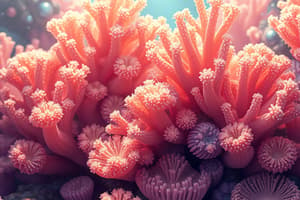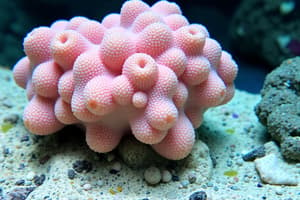Podcast
Questions and Answers
What type of organisms are sponges categorized as?
What type of organisms are sponges categorized as?
- Saprotrophic
- Heterotrophic (correct)
- Autotrophic
- Parasitic
Sponges have a well-defined nervous system.
Sponges have a well-defined nervous system.
False (B)
Name one representative species of freshwater sponges.
Name one representative species of freshwater sponges.
Spongilla lacustris
The largest and most complex body type of sponges is called __________.
The largest and most complex body type of sponges is called __________.
Match the different body types of sponges to their characteristics:
Match the different body types of sponges to their characteristics:
Which characteristic is NOT true for sponges?
Which characteristic is NOT true for sponges?
Sponges can only reproduce asexually through gemules.
Sponges can only reproduce asexually through gemules.
What type of cells create the internal water current in a sponge?
What type of cells create the internal water current in a sponge?
The body type of sponges that has a simple tube with pores is called __________.
The body type of sponges that has a simple tube with pores is called __________.
Match the types of sponge body structures with their descriptions:
Match the types of sponge body structures with their descriptions:
Flashcards
Phylum Porifera
Phylum Porifera
A group of animals that are considered to be the simplest multicellular organisms. They lack true tissues and organs, and instead are organized at the cellular level.
Sponges are filter feeders
Sponges are filter feeders
Sponges are filter feeders, meaning they capture food particles from the water that flows through their bodies. This process occurs inside their cells, a method known as intracellular digestion.
Sponges are sessile (except larvae)
Sponges are sessile (except larvae)
Sponges are sessile, meaning they remain attached to a single location for their entire life. However, their larvae can move freely.
Asconoid body type
Asconoid body type
Signup and view all the flashcards
Syconoid body type
Syconoid body type
Signup and view all the flashcards
What are the two basic types of cells in sponges?
What are the two basic types of cells in sponges?
Signup and view all the flashcards
How are sponges organized?
How are sponges organized?
Signup and view all the flashcards
How do sponges obtain food?
How do sponges obtain food?
Signup and view all the flashcards
What is the mesophyll?
What is the mesophyll?
Signup and view all the flashcards
What are spicules?
What are spicules?
Signup and view all the flashcards
Study Notes
Phylum Sponges (Porifera)
- Sponges belong to the group Diblastica
- They have ectoderm and endoderm layers
- Primarily marine organisms, but some live in fresh water
- Sessile (attached), except for their larvae stage
- Simplest multicellular organisms
- Lack tissues, only cellular-level organization
- Heterotrophic organisms, acting as filter feeders
- Multicellular
- Have two basic cell types: somatic cells and gametes
General Characteristics
- Filter feeders with intracellular digestion
- Lack a nervous or sensory system
Body Structure
- Composed of four cell types:
- Choanocytes: Collar cells lining the spongocoel, create internal water flow using flagella.
- Epidermal cells: Form the outer layer.
- Amoebocytes: Found in the mesohyl, responsible for digestion, nutrient transport, and skeletal support (e.g., spicules).
- Porocytes: Form pores in the sponge body allowing water flow.
- Spicules: Provide structural support to the sponge, composed of calcium carbonate or silica.
Body Types
- Asconoid: Simple tube with pores, single osculum.
- Syconoid: Larger than asconoid, single osculum, thicker body wall allowing for increased surface area and water flow.
- Leuconoid: Largest and most complex, composed of masses of tissues, penetrated by canals, and multiple oscula, greatly increasing water flow and filtering capacity.
Reproduction
- Hermaphrodites
- Asexual reproduction through gemules, which are created in the mesohyl, a gelatinous matrix surrounding cells.
- Sexual reproduction (usually cross-fertilization), releasing sperm.
- Exhibit high regeneration ability.
Representative Sponges
- Spongilla lacustris: Lives in fresh water
- Venus flower basket (Euplectella aspergillum): Marine species, up to 60 cm in size.
Studying That Suits You
Use AI to generate personalized quizzes and flashcards to suit your learning preferences.




